Metabolomic Profile and Antibacterial Bioactivity of Akebia trifoliata (Thunb.) Koidz Pericarp Extract
Abstract
1. Introduction
2. Materials and Methods
2.1. Materials
2.2. Extraction
2.3. Quantitative Analysis by UHPLC-TOF -MS/MS
2.3.1. Liquid Chromatography Conditions
2.3.2. Mass Spectrometry Conditions
2.4. Bacterial Strains and Culture
2.5. Antimicrobial Assay
2.6. Broth Dilution MIC Assay
2.7. Resazurin Microplate Assay
2.8. Determination of Bacterial Mortality
2.9. Bacterial Cell Membrane Permeability
2.10. TEM
2.11. Data Analysis
3. Results
3.1. Metabolomic Profile Analysis of A. trifoliata Extract
3.2. Antimicrobial Activities of Pericarp Extract of A. trifoliata
3.3. Antimicrobial Mechanism
3.4. Antimicrobial Activities of OA, UA, and MA
4. Discussion
5. Conclusions
Supplementary Materials
Author Contributions
Funding
Acknowledgments
Conflicts of Interest
References
- Li, L.; Chen, X.; Yao, X.; Tian, H.; Huang, H. Geographic distribution and resource status of three important Akebia species. J. Wuhan Bot. Res. 2010, 28, 497–506. [Google Scholar]
- Kitaoka, F.; Kakiuchi, N.; Long, C.; Itoga, M.; Mitsue, A.; Mouri, C.; Mikage, M. Molecular characterization of akebia plants and the derived traditional herbal medicine. Biol. Pharm. Bull. 2009, 32, 665–670. [Google Scholar] [CrossRef] [PubMed]
- Wang, X.; Yu, N.; Wang, Z.; Qiu, T.; Jiang, L.; Zhu, X.; Sun, Y.; Xiong, H. Akebia trifoliata pericarp extract ameliorates inflammation through NF-κB/MAPK signaling pathways and modifies gut microbiota. Food Funct. 2020, 11, 4682–4696. [Google Scholar] [CrossRef] [PubMed]
- Maciag, D.; Dobrowolska, E.; Sharafan, M.; Ekiert, H.; Tomczyk, M.; Szopa, A. Akebia quinata and Akebia trifoliata—A review of phytochemical composition, ethnopharmacological approaches and biological studies. J. Ethnopharmacol. 2021, 280, 114486. [Google Scholar] [CrossRef] [PubMed]
- Yu, N.; Wang, X.; Ning, F.; Jiang, C.; Li, Y.; Peng, H.; Xiong, H. Development of antibacterial pectin from Akebia trifoliata var. australis waste for accelerated wound healing. Carbohydr. Polym. 2019, 217, 58–68. [Google Scholar] [CrossRef]
- Jiang, Y.; Yin, H.; Zhou, X.; Wang, D.; Zhong, Y.; Xia, Q.; Deng, Y.; Zhao, Y. Antimicrobial, antioxidant and physical properties of chitosan film containing Akebia trifoliata (Thunb.) Koidz. peel extract/montmorillonite and its application. Food Chem. 2021, 361, 130111. [Google Scholar] [CrossRef]
- Zhao, W.W.; Zan, K.; Wu, J.Y.; Gao, W.; Yang, J.; Ba, Y.Y.; Wu, X.; Chen, X.Q. Antibacterial triterpenoids from the leaves of Ilex hainanensis Merr. Nat. Prod. Res. 2019, 33, 2435–2439. [Google Scholar] [CrossRef]
- Wang, J.; Ren, H.; Xu, Q.L.; Zhou, Z.Y.; Wu, P.; Wei, X.Y.; Cao, Y.; Chen, X.X.; Tan, J.W. Antibacterial oleanane-type triterpenoids from pericarps of Akebia trifoliata. Food Chem. 2015, 168, 623–629. [Google Scholar] [CrossRef]
- Sommerwerk, S.; Heller, L.; Kuhfs, J.; Csuk, R. Urea derivates of ursolic, oleanolic and maslinic acid induce apoptosis and are selective cytotoxic for several human tumor cell lines. Eur. J. Med. Chem. 2016, 119, 1–16. [Google Scholar] [CrossRef]
- Tong, C.; Zhong, X.; Yang, Y.; Liu, X.; Zhong, G.; Xiao, C.; Liu, B.; Wang, W.; Yang, X. PB@PDA@Ag nanosystem for synergistically eradicating MRSA and accelerating diabetic wound healing assisted with laser irradiation. Biomaterials 2020, 243, 119936. [Google Scholar] [CrossRef]
- Hartman, E.G.; Geryl, J. Comparison between the minimal inhibitory concentration of tilmicosin and oxytetracycline for bovine pneumonic Pasteurella haemolytica isolates. Vet. Q. 1993, 15, 184. [Google Scholar] [CrossRef] [PubMed]
- Gong, X.; Liang, Z.; Yang, Y.; Liu, H.; Ji, J.; Fan, Y. A resazurin-based, nondestructive assay for monitoring cell proliferation during a scaffold-based 3D culture process. Regen. Biomater. 2020, 7, 271–281. [Google Scholar] [CrossRef] [PubMed]
- Zhang, C.; Li, X.; Jin, S.; Zhang, H.; Wang, R.; Pei, L.; Zheng, J. The Anti-Proliferative Effect of Flavonoid Nanoparticles on the Human Ovarian Cancer Cell Line SK0V3. J. Nanosci. Nanotechnol. 2020, 20, 6040–6046. [Google Scholar] [CrossRef] [PubMed]
- Çevik, U.A.; Osmaniye, D.; Levent, S.; Sağlik, B.N.; Çavuşoğlu, B.K.; Karaduman, A.B.; Özkay, Y.; Kaplancikli, Z.A. Synthesis and biological evaluation of novel 1,3,4-thiadiazole derivatives as possible anticancer agents. Acta Pharm. 2020, 70, 499–513. [Google Scholar] [CrossRef]
- Yoo, J.H.; Baek, K.H.; Heo, Y.S.; Yong, H.I.; Jo, C. Synergistic bactericidal effect of clove oil and encapsulated atmospheric pressure plasma against Escherichia coli O157:H7 and Staphylococcus aureus and its mechanism of action. Food Microbiol. 2021, 93, 103611. [Google Scholar] [CrossRef]
- Liao, S.; Zhang, Y.; Pan, X.; Zhu, F.; Jiang, C.; Liu, Q.; Cheng, Z.; Dai, G.; Wu, G.; Wang, L.; et al. Antibacterial activity and mechanism of silver nanoparticles against multidrug-resistant Pseudomonas aeruginosa. Int. J. Nanomed. 2019, 14, 1469–1487. [Google Scholar] [CrossRef]
- Tsakou, F.; Jersie-Christensen, R.; Jenssen, H.; Mojsoska, B. The Role of Proteomics in Bacterial Response to Antibiotics. Pharmaceuticals 2020, 13, 214. [Google Scholar] [CrossRef]
- Nagaraj Sowmya, R.; Osborne Jabez, W. Bioactive compounds from Caulerpa racemosa as a potent larvicidal and antibacterial agent. Front. Biol. 2014, 9, 300–305. [Google Scholar] [CrossRef]
- Sankaranarayanan, S.; Bama, P.; Deccaraman, M.; Vijayalakshimi, M.; Murugesan, K.; Kalaichelvan, P.T.; Arumugam, P. Isolation and characterization of bioactive and antibacterial compound from Helianthus annuus linn. Indian J. Exp. Biol. 2008, 46, 831–835. [Google Scholar]
- Evbuomwan, L.; Chukwuka, E.P.; Obazenu, E.I.; Ilevbare, L. Antibacterial activity of Vernonia amygdalina leaf extracts against multidrug resistant bacterial isolates. J. Appl. Sci. Environ. Manag. 2018, 22, 17–21. [Google Scholar] [CrossRef][Green Version]
- Wang, C.; Piao, J.; Li, Y.; Tian, X.; Dong, Y.; Liu, D. Construction of Liposomes Mimicking Cell Membrane Structure through Frame-Guided Assembly. Angew. Chem. (Int. Ed. Engl.) 2020, 59, 15176–15180. [Google Scholar] [CrossRef] [PubMed]
- Pei, S.; Liu, R.; Gao, H.; Chen, H.; Wu, W.; Fang, X.; Han, Y. Inhibitory effect and possible mechanism of carvacrol against Colletotrichum fructicola. Postharvest Biol. Technol. 2020, 163, 111126. [Google Scholar] [CrossRef]
- Li, Y.; Li, B.; Wu, Y.; Zhao, Y.; Sun, L. Preparation of carboxymethyl chitosan/copper composites and their antibacterial properties. Mater. Res. Bull. 2013, 48, 3411–3419. [Google Scholar] [CrossRef]
- Wolska, K.; Grudniak, A.; Fiecek, B.; Kraczkiewicz-Dowjat, A.; Kurek, A. Antibacterial activity of oleanolic and ursolic acids and their derivatives. Open Life Sci. 2010, 5, 543–553. [Google Scholar] [CrossRef]
- Chen, Y.; Li, H.; Wu, L.; Zhang, M.; Gao, Y.; Wang, H.; Xu, D.; Chen, W.; Song, G.; Chen, J. Ursolic acid derivatives are potent inhibitors against porcine reproductive and respiratory syndrome virus. RSC Adv. 2020, 10, 22783–22796. [Google Scholar] [CrossRef]
- Huang, H.; Liang, J.; Tan, Q.; Ou, L.; Li, X.; Zhong, C.; Huang, H.; Møller, I.M.; Wu, X.; Song, S. Insights into triterpene synthesis and unsaturated fatty-acid accumulation provided by chromosomal-level genome analysis of Akebia trifoliata subsp. australis. Hortic. Res. 2021, 8, 33. [Google Scholar] [CrossRef]
- Zhang, Z.; Zhang, J.; Yang, Q.; Li, B.; Zhou, W.; Wang, Z. Genome survey sequencing and genetic diversity of cultivated Akebia trifoliata assessed via phenotypes and SSR markers. Mol. Biol. Rep. 2021, 48, 241–250. [Google Scholar] [CrossRef]
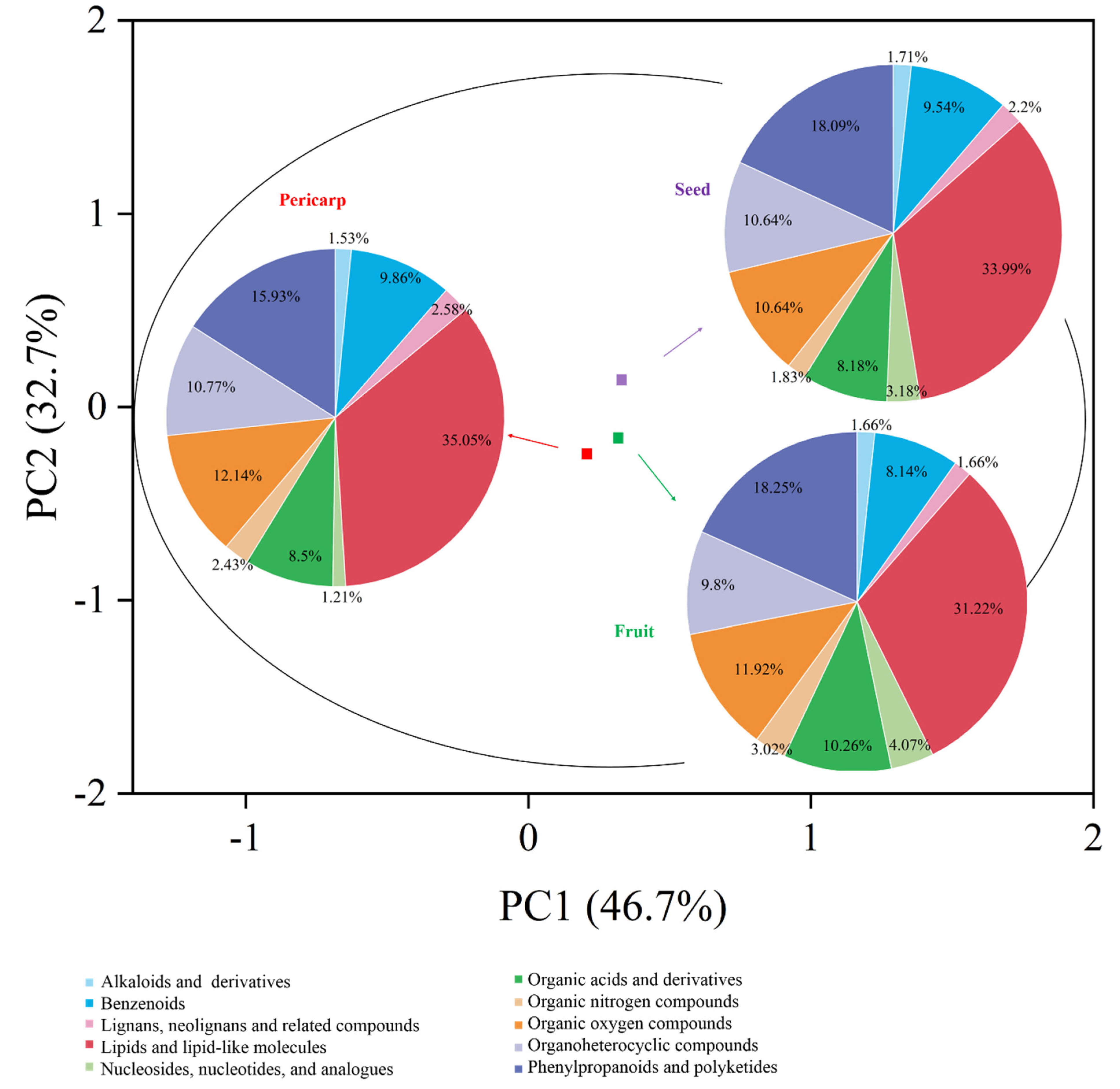
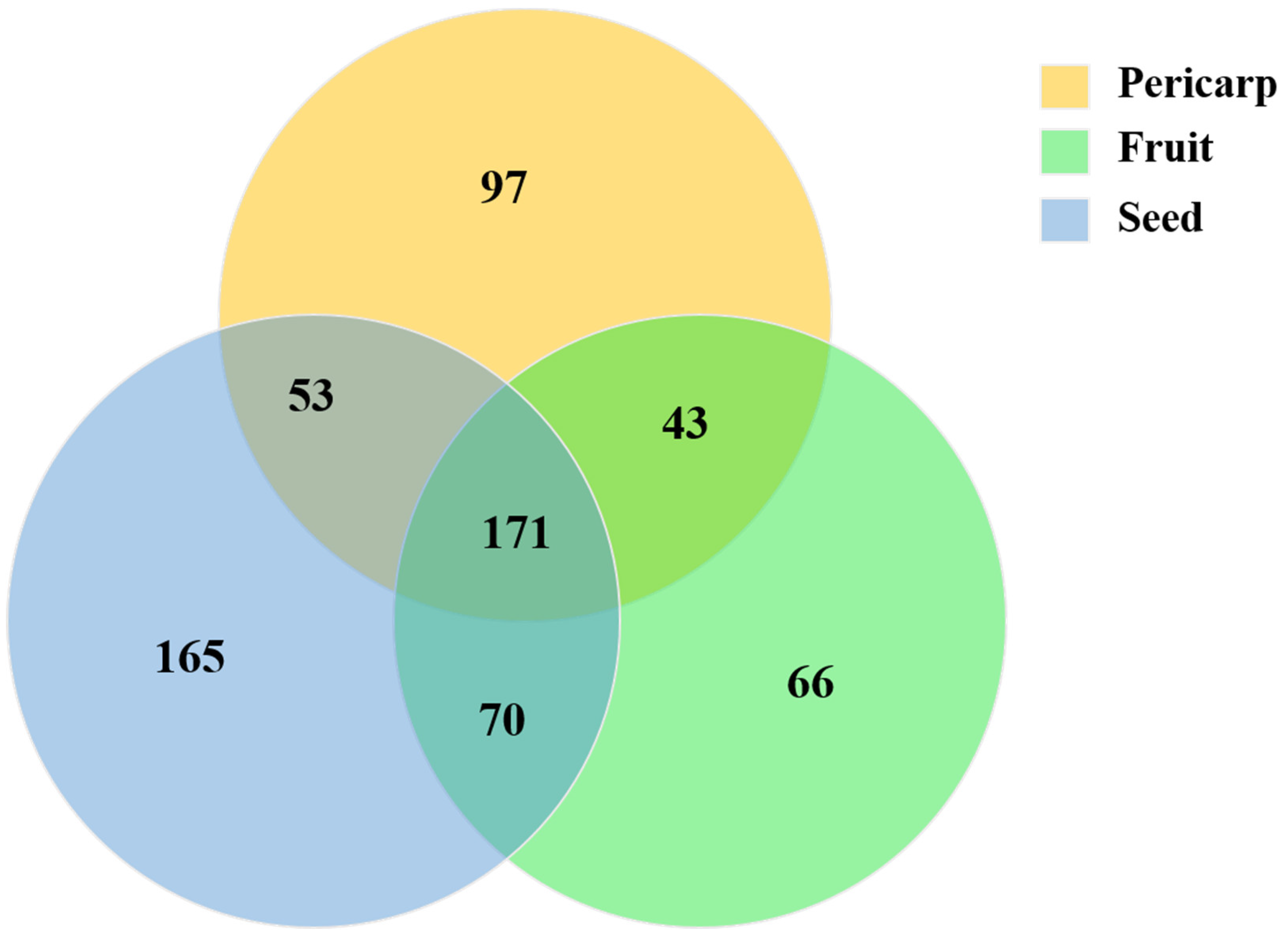

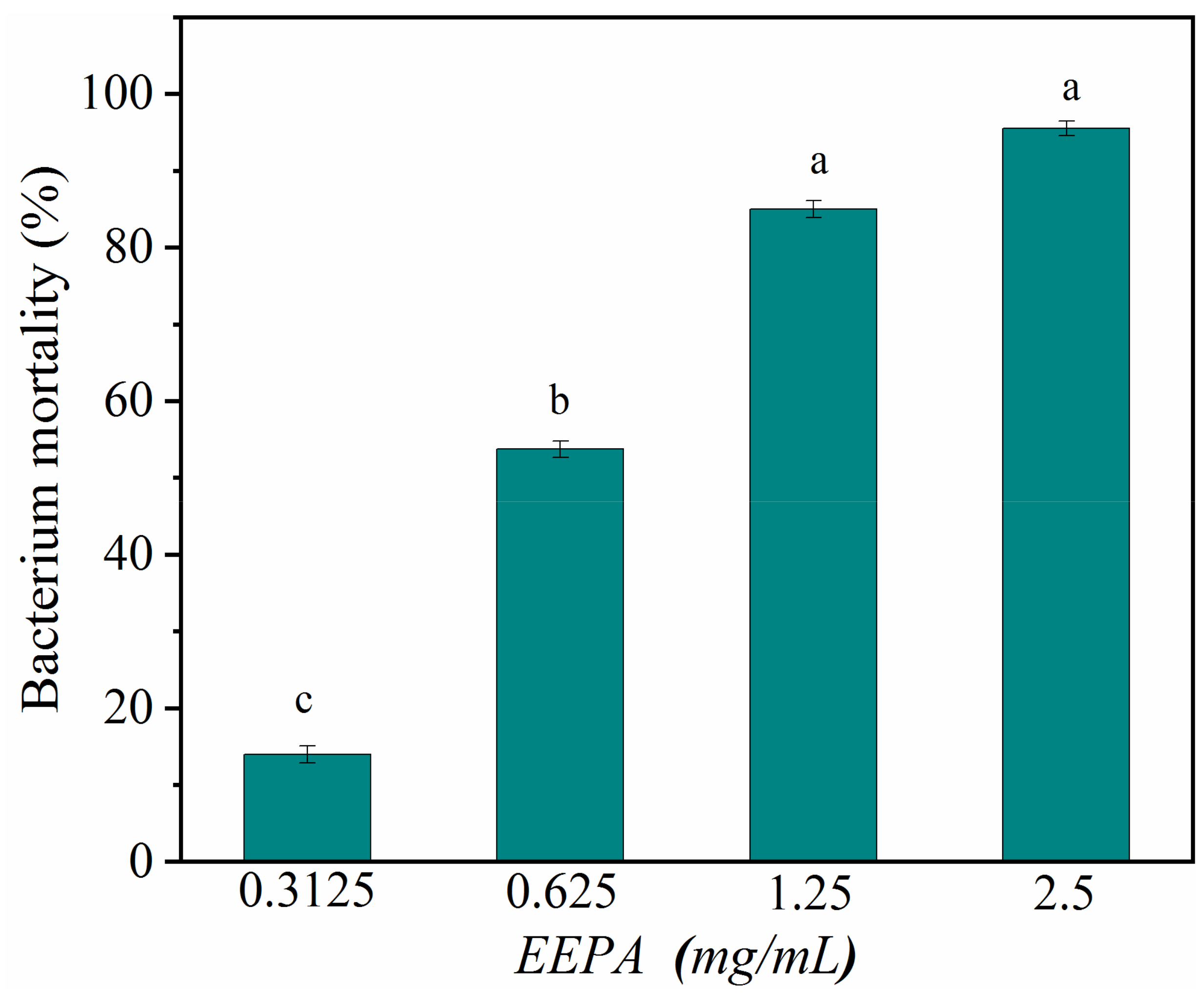
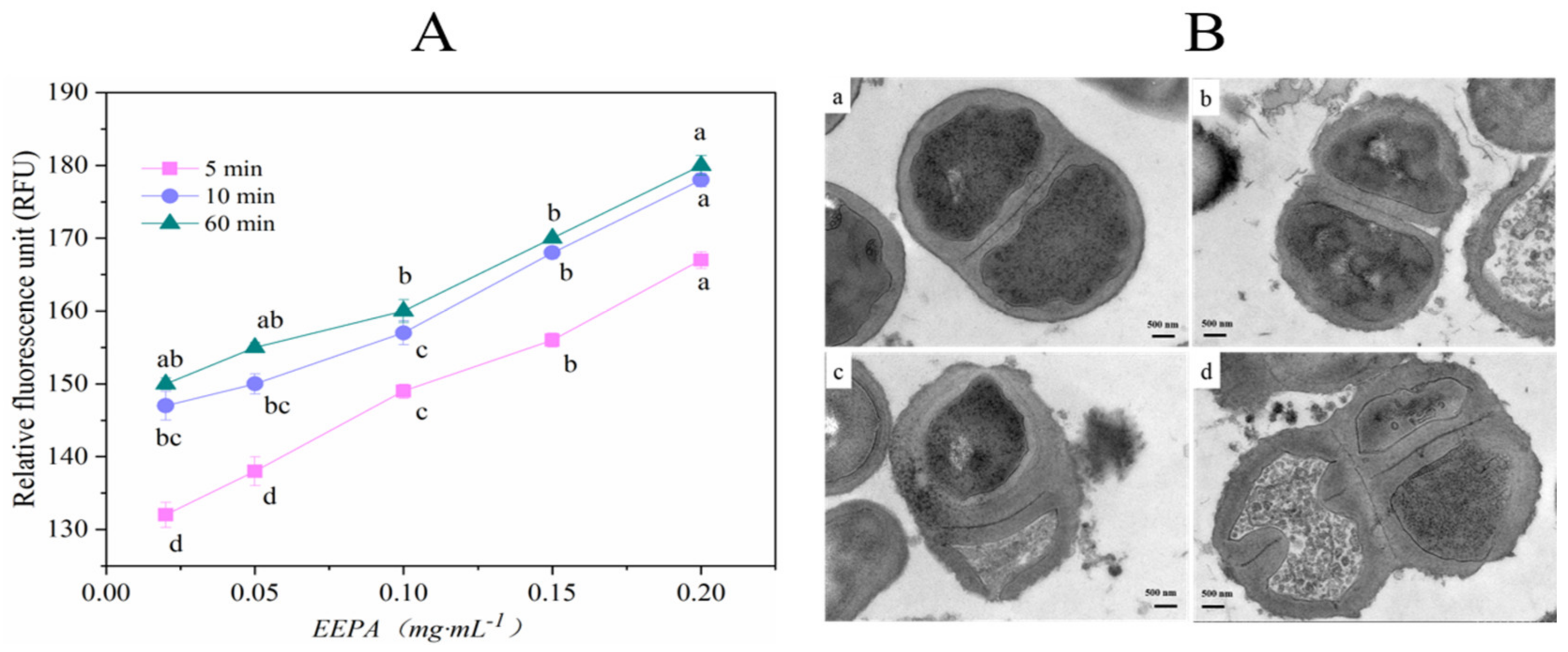
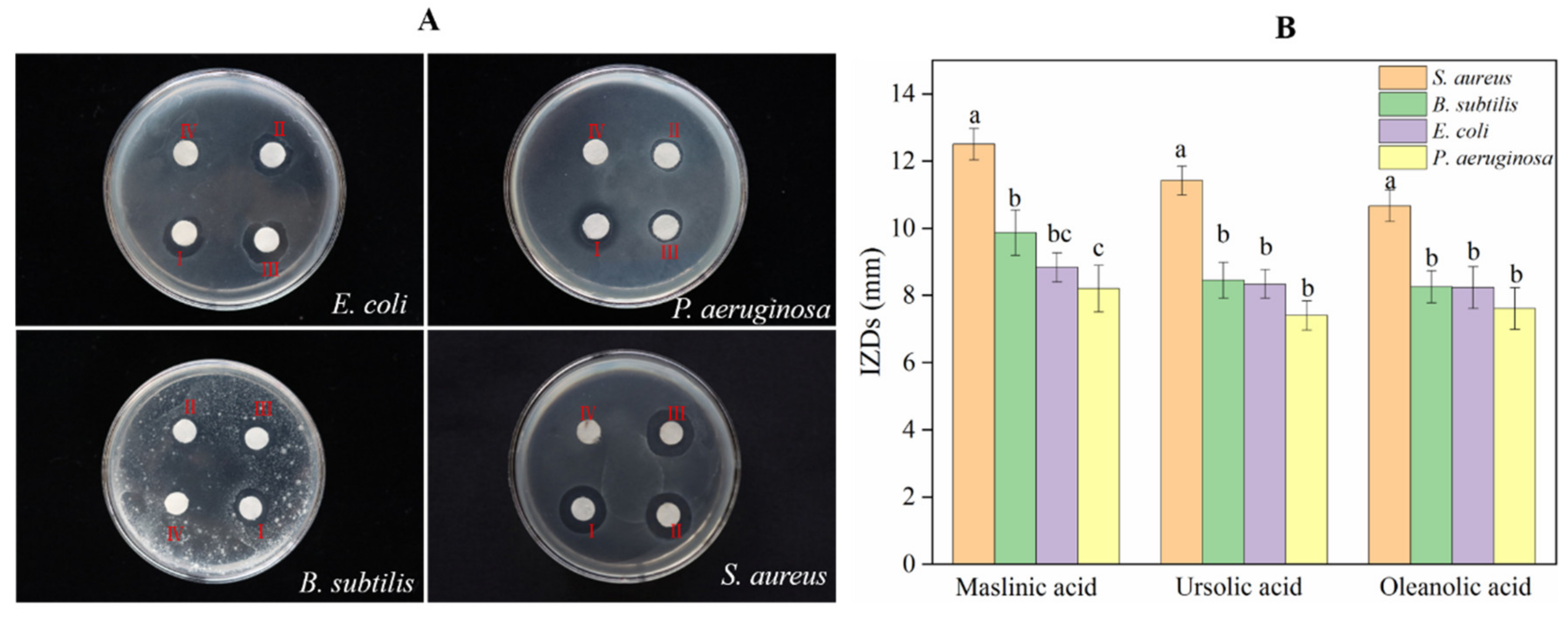


| Identified Metabolites | Formula | Identified Metabolites | Formula |
|---|---|---|---|
| 1 | C22H34O7 | 24 | C30H46O5 |
| 2 | C46H74O16 | 25 | C47H76O18 |
| 3 | C42H70O12 | 26 | C30H50O |
| 4 | C36H56O11 | 27 | C30H46O4 |
| 5 | C36H56O11 | 28 | C29H36O8 |
| 6 | C31H40O11 | 29 | C30H48O3 |
| 7 | C35H54O10 | 30 | C36H56O12 |
| 8 | C30H48O5 | 31 | C30H46O5 |
| 9 | C46H74O16 | 32 | C30H48O3 |
| 10 | C30H46O4 | 33 | C30H48O6 |
| 11 | C41H66O13 | 34 | C41H66O12 |
| 12 | C30H48O3 | 35 | C30H48O3 |
| 13 | C35H44O16 | 36 | C41H66O13 |
| 14 | C30H50O2 | 37 | C30H46O4 |
| 15 | C40H54O3 | 38 | C30H46O6 |
| 16 | C36H60O9 | 39 | C30H46O5 |
| 17 | C30H48O2 | 40 | C30H46O4 |
| 18 | C46H74O17 | 41 | C30H50O5 |
| 19 | C46H74O16 | 42 | C30H48O3 |
| 20 | C30H48O5 | 43 | C30H48O4 |
| 21 | C36H58O12 | 44 | C30H48O4 |
| 22 | C41H66O13 | 45 | C30H48O4 |
| 23 | C30H46O3 |
Publisher’s Note: MDPI stays neutral with regard to jurisdictional claims in published maps and institutional affiliations. |
© 2022 by the authors. Licensee MDPI, Basel, Switzerland. This article is an open access article distributed under the terms and conditions of the Creative Commons Attribution (CC BY) license (https://creativecommons.org/licenses/by/4.0/).
Share and Cite
Chen, J.; Sun, Z.; Chen, J.; Luan, M. Metabolomic Profile and Antibacterial Bioactivity of Akebia trifoliata (Thunb.) Koidz Pericarp Extract. Processes 2022, 10, 1394. https://doi.org/10.3390/pr10071394
Chen J, Sun Z, Chen J, Luan M. Metabolomic Profile and Antibacterial Bioactivity of Akebia trifoliata (Thunb.) Koidz Pericarp Extract. Processes. 2022; 10(7):1394. https://doi.org/10.3390/pr10071394
Chicago/Turabian StyleChen, Jing, Zhimin Sun, Jianhua Chen, and Mingbao Luan. 2022. "Metabolomic Profile and Antibacterial Bioactivity of Akebia trifoliata (Thunb.) Koidz Pericarp Extract" Processes 10, no. 7: 1394. https://doi.org/10.3390/pr10071394
APA StyleChen, J., Sun, Z., Chen, J., & Luan, M. (2022). Metabolomic Profile and Antibacterial Bioactivity of Akebia trifoliata (Thunb.) Koidz Pericarp Extract. Processes, 10(7), 1394. https://doi.org/10.3390/pr10071394






